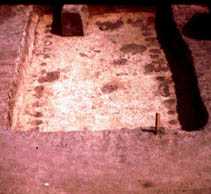
Large storage pits inside a residence.
The correlation between the number and size of storage pits and agricultural productivity seems to be self-evident: Why, after all, build larger and more numerous storage pits unless there was more food to store? However, the type of food being stored, and the manner in which it is stored may also influence both storage pit size and number. Small seeds from floodplain weeds will take up less volume than larger maize kernels, for example. Similarly, cob maize will take up more room than kernels. Nevertheless, the fact that Mississippians continued to use of wild plants and cultivated weeds at the same time they invested in pruductive maize agriculture seems to indicate an increase in food availability.